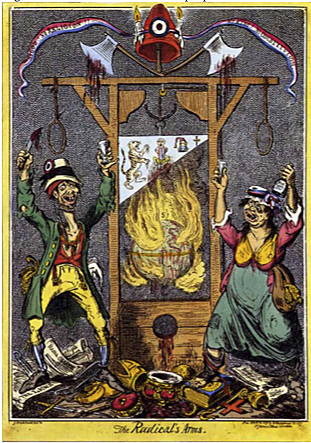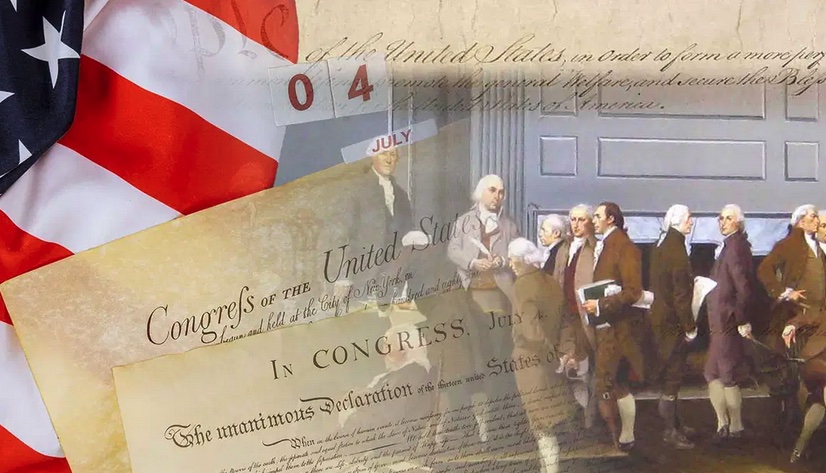
- Articles
Two Epic Revolutions—One a Struggle for Liberty, and the Other for Savagery by Regina Kirkland
Contrasting Ideals and Ends in the American and French Revolutions by Miguel A. Faria, Jr., M.D. is a comprehensive analysis and comparison of the American and French Revolutions—two revolutions that changed the world. Both revolutions were influenced by the Enlightenment and the Age of Reason. However, each revolution took very divergent paths with diametrically opposite outcomes. Dr. Faria highlights the pivotal events of each revolution and describes vividly the participants who led these events. It is a journey through time which demonstrates man’s capacity for both good and evil.
The American Revolution was fought by American patriots to gain their independence from Great Britain. It was forged in the belief of the Natural Rights of men. Thomas Jefferson eloquently and masterfully wrote in the Declaration of Independence, “We hold these truths to be self-evident, that all men are created equal, that they are endowed by their Creator with certain unalienable Rights, that among these are Life, Liberty and the pursuit of Happiness.” Out of this struggle for independence, a new nation was created—The United States of America.

The Founding Fathers chose a constitutional republic as its form of government, not a democracy. Dr. Faria states, “Because of the wisdom of the Founding Fathers in establishing a representative form of government with checks and balances—that is, a constitutional republic rather than the simple majority rule of a democracy—the United States has been blessed with unprecedented freedom and prosperity.” The founding document of this nation was the Constitution. Dr. Faria writes, “The U.S. Constitution remains the greatest document ever drafted for self-governance, written by the hearts and minds of men inspired by the wisdom of the ages, if not by the very hand, what they themselves believed to be, of Nature’s God.” As an American, I am forever thankful for the founder’s wisdom, knowledge, and their greatness!
In direct contrast to the American Revolution, the French revolutionaries exhibited the worst of human nature. Their adopted slogan of liberté, égalité, fraternité was distorted rhetoric. Under the despot Maximilien Robespierre and his despicable associates—Louis-Antoine de Saint-Just, Georges Couthon, Jean-Marie Collot d’Herbois, Jacques-Nicolas Billaud-Varenne, etc.—the French Revolution descended into anarcho-tyranny and bloodshed.
In relating the savagery of the French Revolution, so unlike the American struggle for liberty, Dr. Faria wrote:
Jean-Baptiste Carrier (1756–1794) became the murderer of Nantes (Brittany). Carrier orchestrated the grisly noyades (‘execution by drowning’) in the Loire, the longest river in France, to speed up the destruction of the purported ‘enemies of the Revolution’ since he deemed trial to be a waste of time. Barges were loaded first with priests and taken to the middle of the Loire and scuttled. Naked men and women were bound together in what Carrier called ‘Republican marriages,’ and placed aboard the barges. Their children were included because ‘Wolflings grow to be wolves.’ The barges were then towed to the middle of the river and the victims were thrown overboard. Those who tried to cling to the boats had their hands or fingers cut off with swords by the revolutionary thugs. In this manner, Carrier ‘disposed of some four thousand undesirables in four months.’ The total number of deaths by the noyades was estimated to be in excess of six thousand victims, according to a member of Carrier’s committee.
No one was safe from the Committee of Public Safety or the cold blade of the guillotine. Why did this happen? In the Epilogue, Dr. Faria answers this question. He states, “Despite the adoption of the Declaration of the Rights of Man and of the Citizen, the French revolutionists failed to establish a lasting constitutional republic, or even a republic that respected the rule of law, due process, and equality before the law. The French revolutionists attempted to create a new social order by severing not only political but also religious connections with the past. Moreover, they attempted to remake man and to change human nature. They failed to understand that forced fraternity and equality were mutually exclusive from individual liberty.”
The American Revolution inspired self-determination and freedom throughout the world. The French Revolution inspired savagery and totalitarianism. Dr. Faria reminded us: “A century and one quarter later the French Revolution inspired the destructive Russian Revolution of 1917 with its communist aftermath and legacy of suffering and death. Karl Marx and Friedrich Engels studied the French Revolution, hoping that a truly communist revolution would exceed it. Vladimir Lenin and Leon Trotsky reveled in their achievement, recognizing some French revolutionists, particularly Maximilien Robespierre, as mentors.”
In Appendix A-J of Contrasting Ideals and Ends in the American and French Revolutions, Dr. Faria discusses more recent political events that were consequences of both revolutions, events that still reverberate in our time and are relevant to today’s happenings. This book is not only a work of comparative history, but also of literature as well as aesthetic art. It contains 179 illustrations and 32 pages of color plates. If you want to learn about the American and French Revolutions in one book, you should buy this book and read. You will not be disappointed!
Regina Kirkland is a concerned citizen living in Georgia (USA).
Copyright ©2025 HaciendaPublishing.com